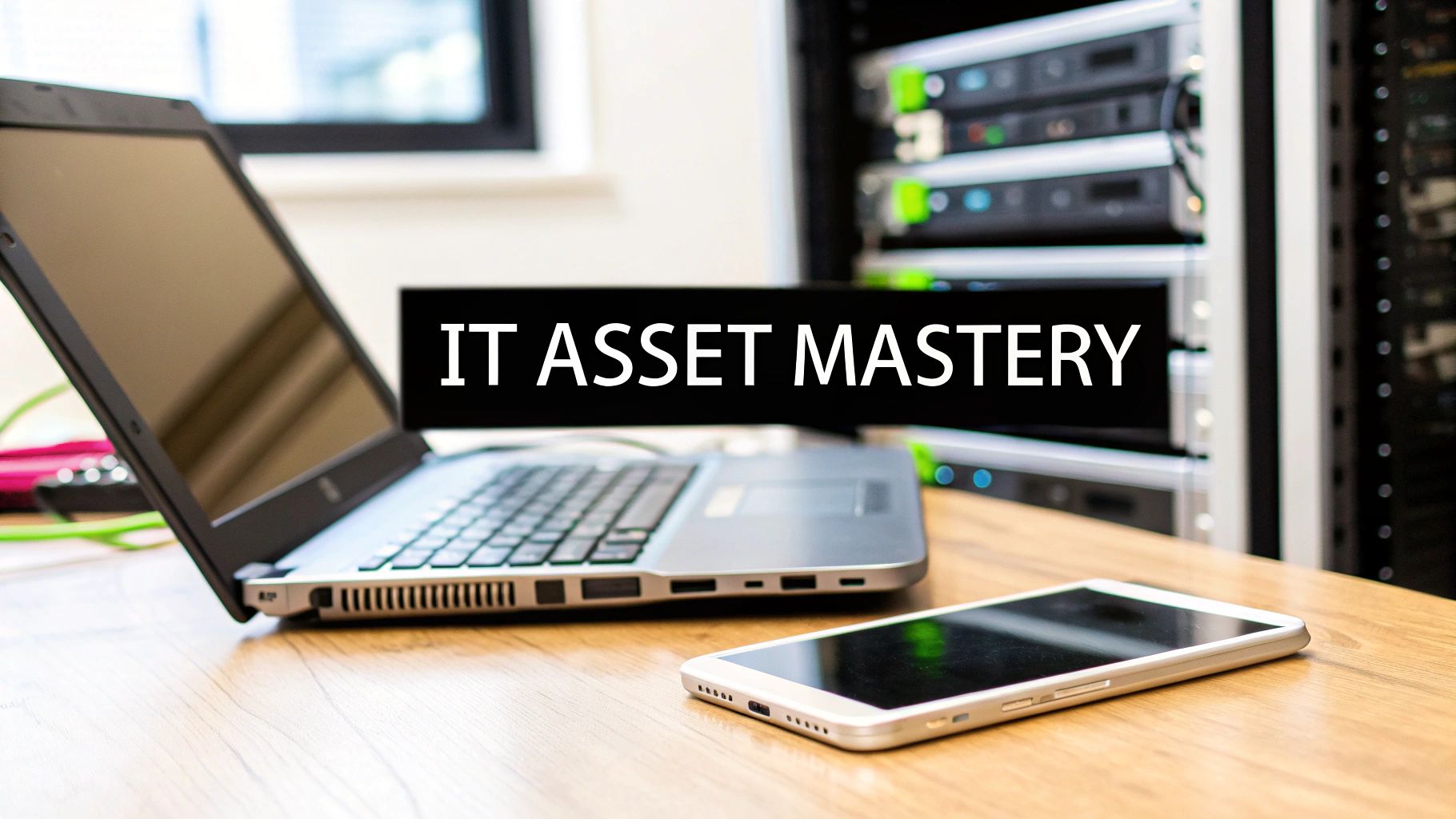In today's complex business environment, every piece of hardware, software license, and cloud subscription represents a critical investment and a potential vulnerability. Managing these assets effectively is no longer just an IT function; it's a core business strategy essential for operational stability and growth. Poor management leads directly to wasted budgets on unused software, crippling security breaches from unpatched devices, and severe penalties from compliance failures. This is where a focused approach to IT asset management best practices becomes a competitive advantage.
This guide cuts through the noise to deliver seven essential, actionable strategies designed for modern enterprises, from hospitality groups to commercial retail businesses. We will move beyond theory to provide practical implementation details that help you gain complete control over your technology portfolio. By implementing these proven methods, you can optimize spending, fortify security, and transform your IT infrastructure from a reactive cost center into a strategic driver of efficiency. Let's explore the concrete steps you can take to secure and streamline your operations, ensuring your technology assets fully support your business goals.
1. Comprehensive IT Asset Discovery and Inventory Management
Effective IT asset management begins with a fundamental principle: you cannot manage what you do not know you have. This is why a comprehensive IT asset discovery and inventory process is one of the most critical it asset management best practices. It involves systematically identifying, cataloging, and maintaining a complete record of every IT asset within your organization. This extends beyond just physical hardware like servers and laptops to include software licenses, virtual machines, mobile devices, and cloud-based services.
The primary goal is to create a single, unified source of truth for all IT assets. This centralized inventory provides the foundation for all other ITAM activities, from security and compliance to financial planning and lifecycle management. It eliminates shadow IT, reduces waste from unused licenses, and ensures you have a clear picture of your entire technology landscape.
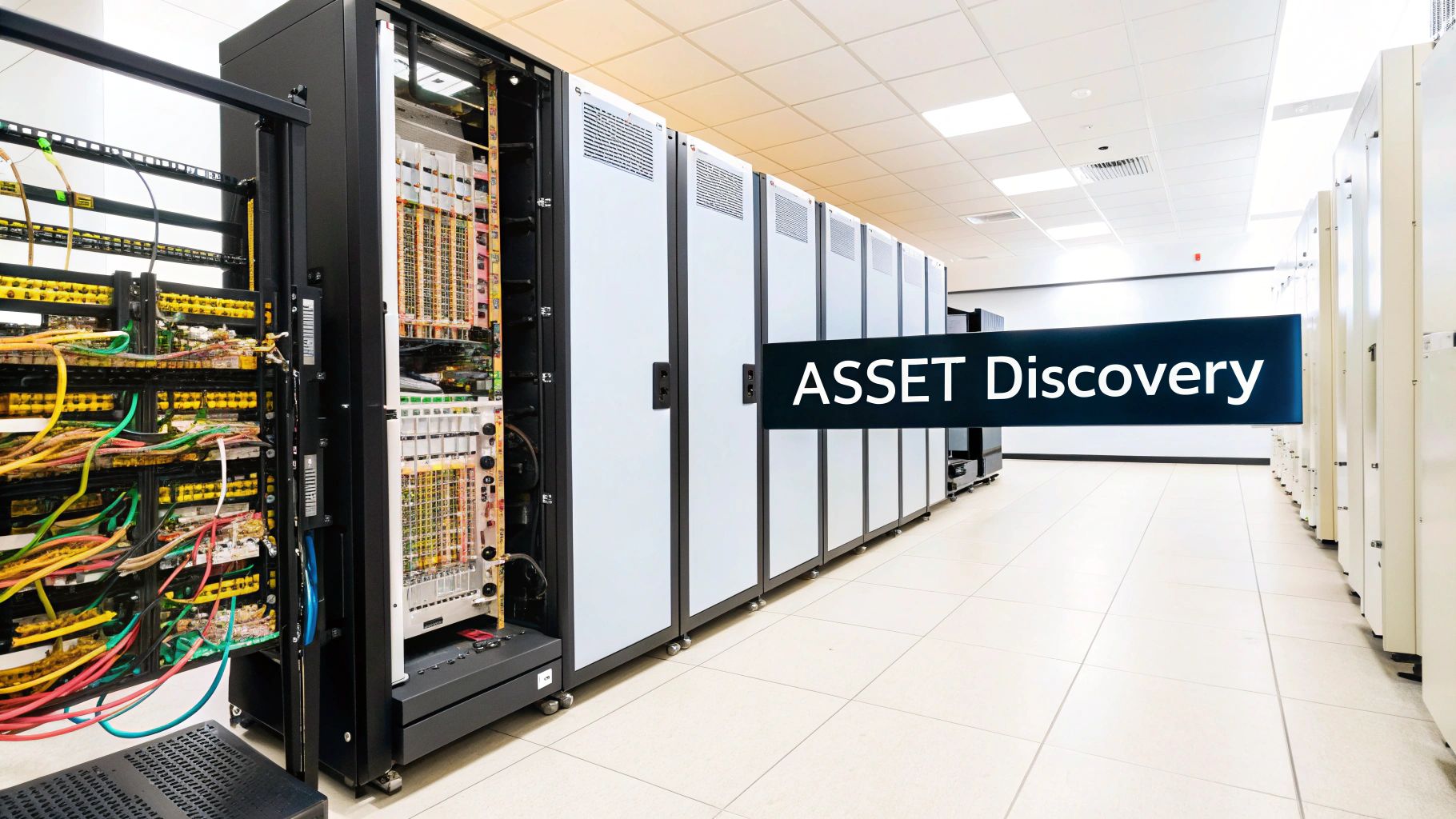
Why This Practice is Essential
Without a complete inventory, organizations operate with significant blind spots. These gaps can lead to security vulnerabilities from unpatched devices, non-compliance with software licensing agreements, and unnecessary spending on redundant assets. For businesses in hospitality or multi-family residential sectors, this could mean unaccounted-for networking equipment, point-of-sale systems, or smart-building devices, all of which pose potential risks. A thorough inventory provides the visibility needed to mitigate these risks and optimize resource allocation.
Implementation in the Real World
Large enterprises have long championed this approach. For example, a global company like General Electric uses automated network discovery tools from providers like Lansweeper to scan its vast global facilities, identifying every device connected to the network without manual intervention. This allows them to maintain an accurate, up-to-date inventory across continents, crucial for security and operational efficiency.
Actionable Steps for Implementation
To build your own comprehensive inventory, follow these targeted steps:
- Start with Automation: Deploy automated discovery tools that can scan your network to find hardware, software, and virtual assets. These tools reduce manual effort and human error.
- Establish a Schedule: Implement regular, automated scanning (daily or weekly) to capture new assets and changes to existing ones, keeping your inventory current.
- Use Agent-Based Tools: For detailed software inventory and usage metrics, deploy agent-based discovery on endpoints like laptops and servers. This provides deeper insights than network scanning alone.
- Standardize Naming: Create and enforce standardized naming conventions for all assets. Consistent naming makes searching, sorting, and reporting far more efficient.
- Integrate and Automate: Connect your discovery tools with your IT Service Management (ITSM) platform, like ServiceNow or BMC. This integration automates workflows, such as creating a service ticket when an unauthorized device is detected.
2. Software License Management and Compliance
Beyond hardware, one of the most complex and financially significant areas of ITAM is software. Effective software license management and compliance is a cornerstone it asset management best practice that involves tracking, managing, and optimizing software entitlements to ensure adherence to vendor agreements while minimizing costs. This discipline focuses on monitoring software installation and usage, managing license renewals, and conducting regular internal audits to prevent costly non-compliance penalties and reduce overspending on unused software.
The primary goal is to gain complete control over your software portfolio, ensuring every application is properly licensed and utilized efficiently. A strong Software Asset Management (SAM) program prevents the financial and legal risks of vendor audits, identifies opportunities for cost savings by re-harvesting unused licenses, and provides data-driven insights for negotiating future software contracts. This is especially critical in environments like hospitality or multi-family properties where specialized property management, security, and POS software can represent significant investments.
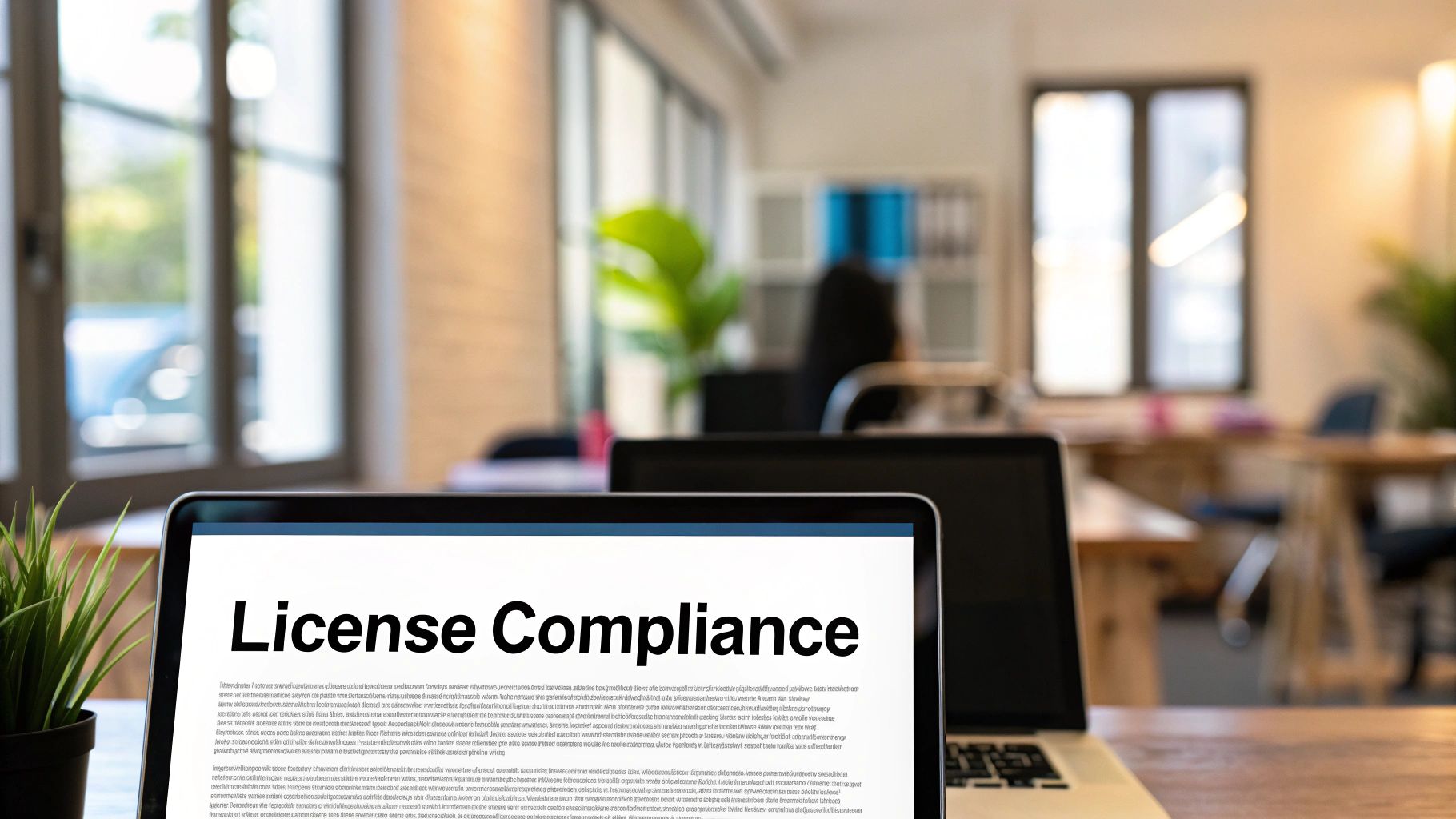
Why This Practice is Essential
Without diligent software management, organizations are exposed to substantial financial and operational risks. A surprise audit from a major vendor like Oracle or Microsoft can result in fines reaching hundreds of thousands or even millions of dollars. Conversely, over-provisioning licenses leads to significant wasted expenditure. Proactive SAM provides the necessary oversight to balance compliance with cost-efficiency, ensuring you only pay for the software you actually need and use.
Implementation in the Real World
Major corporations have demonstrated the immense value of this practice. IBM, for instance, famously saved over $200 million annually through its internal SAM program by optimizing license usage and retiring unnecessary software. Similarly, Siemens implemented comprehensive SAM practices and successfully reduced its overall software spending by 15%, showcasing the direct financial benefits of a well-executed strategy.
Actionable Steps for Implementation
To establish robust software license management, follow these actionable steps:
- Establish a SAM Team: Designate a dedicated team or individual responsible for software asset management. This ensures accountability and focused effort.
- Implement Software Metering Tools: Deploy tools like those from Flexera or Snow Software to automatically discover installed software and track actual application usage. This data is crucial for identifying underutilized licenses.
- Maintain a Centralized License Repository: Create a single, secure location to store all software purchase records, contracts, and entitlement documents. This simplifies audit preparations and renewal management.
- Conduct Regular Internal Audits: Proactively perform your own compliance checks on high-risk vendors annually. This helps identify and resolve potential issues before an official vendor audit occurs.
- Negotiate Enterprise Agreements: For widely used software, consolidate purchases into enterprise-level agreements to leverage volume discounts and simplify license administration.
3. Asset Lifecycle Management
A truly effective approach to ITAM extends beyond just knowing what you have; it involves managing an asset’s entire journey from procurement to disposal. This holistic view is the core of asset lifecycle management, one of the most vital it asset management best practices. It encompasses every stage: planning, acquisition, deployment, maintenance, and finally, secure retirement. The goal is to maximize the value derived from each asset while minimizing costs and risks throughout its operational life.
This strategic process ensures that every piece of hardware and software is not only accounted for but also actively managed to optimize performance, security, and financial return. From the initial purchase order to the final data wipe, tracking an asset's lifecycle provides critical insights for budgeting, compliance, and operational planning. Just as IT assets have a lifecycle, effectively managing the associated contracts (like licenses and warranties) is crucial. You can learn more about mastering contract lifecycle management to complement your ITAM strategy.
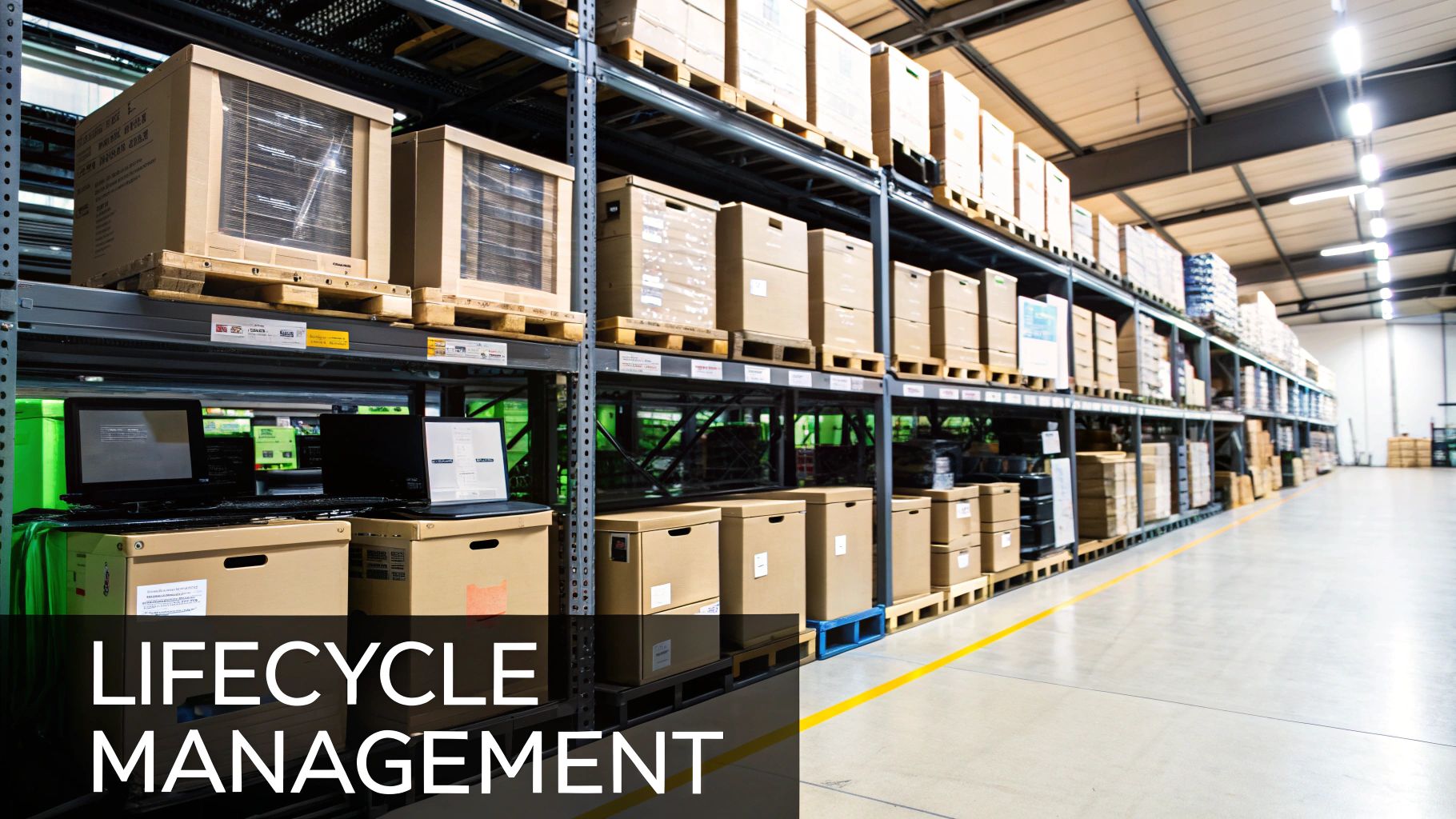
Why This Practice is Essential
Without a defined lifecycle strategy, organizations often face inflated total cost of ownership (TCO), unexpected hardware failures, and significant security vulnerabilities from end-of-life devices. For a hospitality chain, this could mean outdated point-of-sale systems that are no longer supported by the vendor, exposing sensitive guest data. By actively managing the lifecycle, businesses can proactively plan for upgrades, budget for replacements, and ensure that all assets are retired securely, preventing data breaches and ensuring regulatory compliance.
Implementation in the Real World
Tech giants and forward-thinking enterprises have mastered this practice. For instance, Amazon manages the lifecycle of millions of servers in its global data centers with meticulous precision. They use sophisticated systems to track performance, schedule preventative maintenance, and determine the optimal time for decommissioning to maximize efficiency and minimize energy consumption. Similarly, HP's Device as a Service (DaaS) offering bundles hardware, support, and analytics into a single subscription, effectively outsourcing the entire device lifecycle management process for its customers.
Actionable Steps for Implementation
To implement a robust asset lifecycle management program, follow these steps:
- Define Clear Lifecycle Stages: Document distinct stages (e.g., Procurement, In-Use, In-Repair, Retired) with specific criteria for how an asset moves from one stage to the next.
- Establish Refresh Cycles: Create a policy for hardware and software refresh cycles based on a TCO analysis, performance data, and business needs, not just on age.
- Automate Key Tasks: Use your ITAM software to automate reminders for warranty renewals, lease expirations, and scheduled maintenance to prevent costly oversights.
- Develop Secure Disposal Procedures: Create a standardized, documented process for asset disposal that includes certified data erasure, physical destruction where necessary, and environmentally responsible recycling.
- Track Lifecycle Metrics: Monitor key performance indicators like asset uptime, maintenance costs, and residual value to continuously identify opportunities for optimization and cost savings.
4. Configuration Management Database (CMDB) Implementation
While an inventory tells you what you have, a Configuration Management Database (CMDB) tells you how it all connects. Implementing a CMDB is a core component of advanced it asset management best practices. It acts as a central repository that not only stores information about your IT assets (known as Configuration Items or CIs) but also maps the critical relationships between them, business services, and processes.
A CMDB provides the context needed for strategic decision-making. For example, it can show you which servers support your property management software or which network switches are critical for guest Wi-Fi access. This relational data is invaluable for impact analysis, change management, and rapid incident resolution, transforming your ITAM from a simple list into an intelligent, interconnected map of your technology ecosystem.
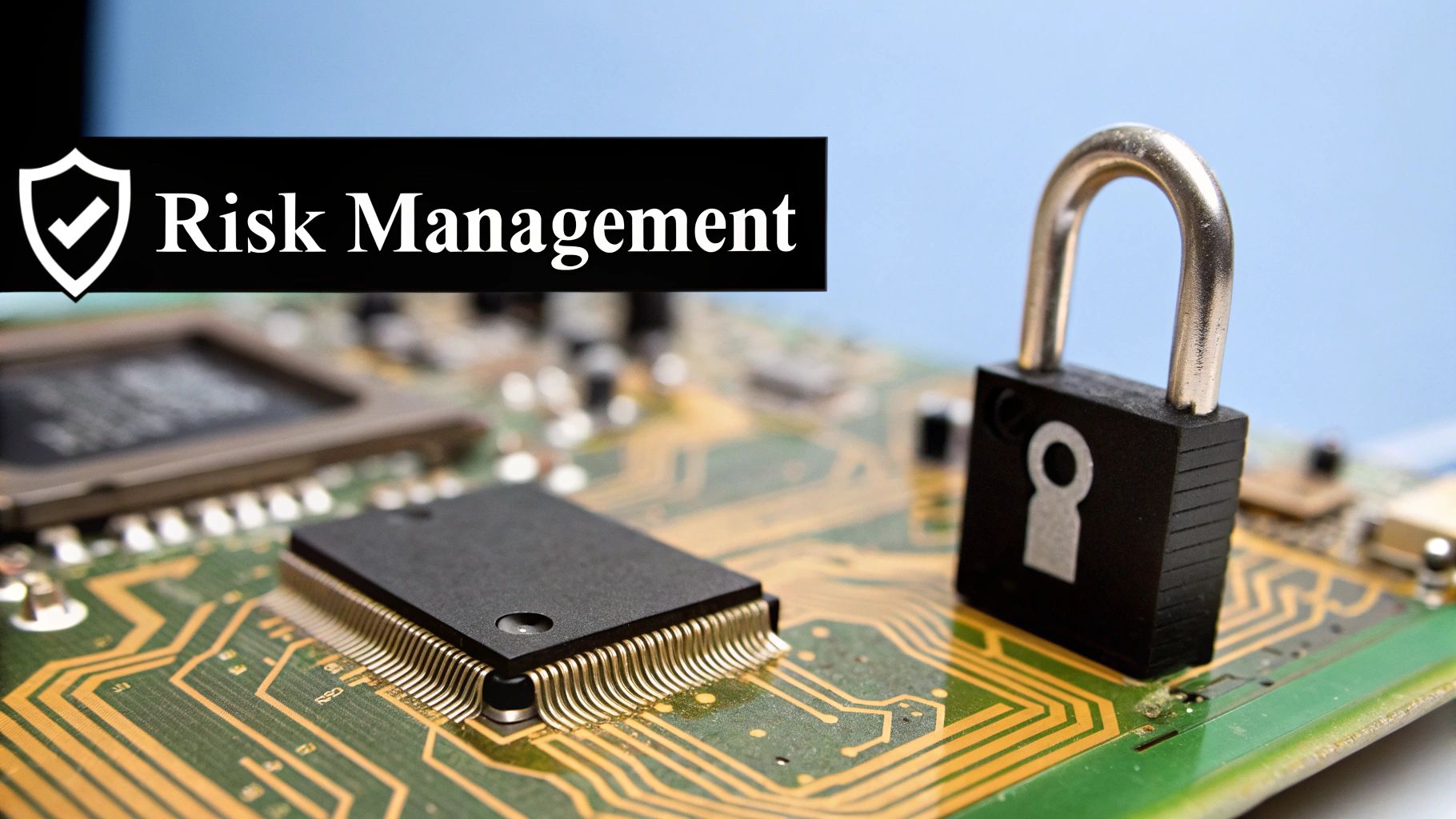
Why This Practice is Essential
Without a CMDB, it's nearly impossible to understand the downstream impact of a change or an outage. When a server fails, you are left scrambling to figure out which applications and services are affected. A well-maintained CMDB eliminates this guesswork. For a multi-family property, it means understanding that a single network switch failure could impact everything from smart-lock access systems to tenant internet services, allowing for proactive communication and faster resolution.
Implementation in the Real World
The IT Infrastructure Library (ITIL) framework heavily popularized the CMDB concept, and platforms like ServiceNow and BMC Software have made it a cornerstone of their offerings. For instance, Lufthansa leveraged its ServiceNow CMDB to map service dependencies, which reportedly improved its incident response times by 40%. By having a clear view of how CIs relate to one another, their IT teams could instantly identify the root cause of issues and understand the full business impact.
Actionable Steps for Implementation
Implementing a CMDB requires a strategic, phased approach to avoid becoming overwhelmed:
- Start with a Pilot Scope: Don't try to map your entire organization at once. Begin with a single critical business service, like your point-of-sale system or guest Wi-Fi, and build out from there.
- Focus on Data Quality: Prioritize the accuracy of a small, well-defined set of data over a large volume of questionable information. A trustworthy CMDB is more valuable than a comprehensive but inaccurate one.
- Establish Clear Ownership: Assign clear responsibility for maintaining the data for different types of CIs. For example, the networking team owns router and switch data, while the server team owns server CIs.
- Automate Data Population: Use your discovery tools to automatically populate and update the CMDB. This reduces manual effort, minimizes errors, and ensures the data remains current.
- Schedule Regular Audits: Implement processes to regularly audit the CMDB for accuracy and completeness, correcting discrepancies to maintain its integrity as the single source of truth.
5. Financial Management and Cost Optimization
Effective IT asset management goes beyond tracking physical devices; it's a powerful financial tool. This is why disciplined financial management and cost optimization is one of the most vital it asset management best practices. It involves systematically tracking, analyzing, and managing all costs associated with IT assets throughout their entire lifecycle, from procurement and deployment to maintenance and disposal. This practice provides a clear view of the Total Cost of Ownership (TCO) for your technology investments.
The primary goal is to align IT spending with business value, ensuring every dollar is used efficiently. By implementing this practice, you can accurately forecast budgets, allocate costs to specific departments or properties, and identify significant opportunities for savings. This transforms IT from a simple cost center into a strategic partner that drives financial efficiency.
Why This Practice is Essential
Without a clear financial lens, IT spending can quickly spiral out of control. Organizations may overspend on underutilized software, hold onto expensive, aging hardware, or miss opportunities to consolidate services. For businesses in hospitality or multi-family residential sectors, this could mean failing to account for the ongoing operational costs of guest Wi-Fi systems or smart-home devices, leading to inaccurate budgeting and reduced profitability. A strong financial management process provides the data needed to make informed, cost-effective decisions.
Implementation in the Real World
Financial giants have perfected this approach out of necessity. JPMorgan Chase, for example, implemented a comprehensive IT cost management program that analyzes every aspect of its technology spend. This granular visibility allowed them to optimize infrastructure and renegotiate vendor contracts, reportedly saving the company over $1.5 billion annually. This demonstrates how a strategic focus on asset finance can yield massive returns.
Actionable Steps for Implementation
To integrate financial management into your ITAM strategy, follow these targeted steps:
- Implement Automated Cost Tracking: Use ITAM or financial management tools to automatically track costs associated with hardware, software licenses, and cloud services. This reduces manual effort and provides real-time data.
- Establish Cost Transparency: Create detailed reports and dashboards that clearly show where IT dollars are being spent. Share this information with department heads to foster accountability.
- Benchmark Against Industry Peers: Regularly compare your IT spending against industry benchmarks to identify areas where you may be overspending and to set realistic optimization goals.
- Analyze the Full Lifecycle: Calculate the TCO for key assets, including purchase price, maintenance, support, and disposal costs, to make smarter procurement decisions.
- Make Optimization an Ongoing Process: Treat cost optimization as a continuous cycle of analysis, action, and review, not a one-time project. For more insights on this, you can learn more about effective IT cost-saving strategies.
6. Security and Risk Management Integration
Treating IT asset management as a purely logistical or financial function is a critical mistake. Integrating security and risk management directly into your ITAM framework is one of the most vital it asset management best practices. This practice involves viewing every asset through a security lens, from procurement to disposal, ensuring that vulnerability management, compliance monitoring, and risk classification are core components of the asset lifecycle.
The primary objective is to transform your asset inventory from a simple list into a dynamic risk-management tool. This approach enables you to prioritize security efforts based on asset criticality, automate vulnerability scanning, and ensure that all hardware and software meet established security baselines. By embedding security into ITAM, you proactively identify and mitigate threats rather than reacting to them after an incident occurs.
Why This Practice is Essential
Without security integration, an IT asset inventory is just a catalog of potential vulnerabilities. Unmanaged devices, unpatched software, and misconfigured systems create entry points for cyberattacks. For businesses managing sensitive guest data in hospitality or resident information in multi-family properties, a security-first ITAM approach is non-negotiable. It helps prevent data breaches, ensures compliance with regulations like PCI DSS and GDPR, and protects the organization's reputation.
Implementation in the Real World
Financial institutions are leaders in this domain due to strict regulatory requirements. For instance, Bank of America employs a sophisticated risk-based IT asset classification system. Assets are categorized based on the sensitivity of the data they handle and their importance to business operations, allowing the security team to apply more stringent controls and monitoring to high-risk assets, optimizing security resources and reducing the overall attack surface.
Actionable Steps for Implementation
To integrate security and risk management into your ITAM strategy, follow these targeted steps:
- Classify Assets by Risk: Develop a classification system that categorizes assets based on business criticality, data sensitivity, and potential security impact. This helps prioritize security efforts.
- Establish Security Baselines: Create and enforce standardized security configurations for different asset types (e.g., servers, workstations, network devices) to ensure they are deployed in a secure state.
- Automate Vulnerability Scanning: Integrate tools from providers like Qualys or Tenable to automatically scan all managed assets for known vulnerabilities and link the findings directly to the asset record in your inventory.
- Involve Security Teams in Governance: Ensure that cybersecurity personnel are active members of your ITAM governance board to provide input on policies, procurement decisions, and disposal procedures.
- Conduct Regular Security Audits: Periodically audit your asset management processes to verify compliance with security policies and identify any gaps in your controls. For complex environments, it's often wise to explore how to choose managed IT security solutions to supplement in-house capabilities.
7. Automation and Integration
In a modern, dynamic IT environment, manual processes are a significant bottleneck, leading to errors, delays, and increased costs. This is where automation and integration become one of the most transformative it asset management best practices. This practice involves using technology to automate repetitive ITAM tasks and connecting your ITAM system with other critical business platforms like ITSM, HR, and finance. It transforms ITAM from a static record-keeping function into a dynamic, responsive business process.
The goal is to create a seamless flow of data and actions across systems, reducing manual intervention and ensuring data accuracy. To truly unlock the potential of ITAM, organizations must embrace advanced automation. This can be achieved by understanding workflow automation and applying its principles to asset lifecycle events, such as provisioning, patch management, and de-provisioning. Automation makes ITAM more efficient, reliable, and scalable.
Why This Practice is Essential
Without automation, IT teams spend countless hours on routine tasks like software installation, license reclamation, and updating asset records. This not only drains resources but also introduces the risk of human error, which can lead to security gaps or compliance violations. By integrating systems, you ensure that an employee's departure recorded in the HR system automatically triggers a workflow to reclaim their hardware and software licenses, closing security loopholes and preventing license waste. This level of process efficiency is critical for modern operations. Learn more about improving operational efficiency.
Implementation in the Real World
Tech giants have perfected this approach to manage their vast infrastructures. Netflix, for instance, heavily relies on custom APIs and machine learning to automate its cloud infrastructure management. When a new service is needed, assets are provisioned, configured, and deployed automatically, with the ITAM system updated in real-time. Similarly, Adobe integrates its asset management platform with its HR system to automate the entire employee lifecycle, from onboarding new hires with the right equipment to securely offboarding them.
Actionable Steps for Implementation
To implement automation and integration in your ITAM strategy, follow these steps:
- Prioritize High-Volume Tasks: Start by identifying and automating routine, high-volume processes like software requests, password resets, or new device provisioning.
- Leverage Standard APIs: Use systems with robust, well-documented APIs (Application Programming Interfaces) to ensure seamless integration between your ITAM tool and other platforms like ServiceNow, Workday, or Ansible.
- Implement Workflow Automation: Use tools like Microsoft Power Automate or Red Hat Ansible to build automated workflows that trigger actions based on specific events, such as a new device being discovered on the network.
- Establish Error Handling: Build robust error handling and rollback procedures into your automations to prevent a single failure from causing cascading problems.
- Maintain Human Oversight: While automation is powerful, ensure that a human-in-the-loop approach is maintained for critical decisions, such as de-provisioning high-value assets or making significant configuration changes.
7 Best Practices Comparison Matrix
| Item | Implementation Complexity 🔄 | Resource Requirements ⚡ | Expected Outcomes 📊 | Ideal Use Cases 💡 | Key Advantages ⭐ |
|---|---|---|---|---|---|
| Comprehensive IT Asset Discovery and Inventory Management | High – requires setup of automated tools & manual audits | Moderate to High – network tools, staff for maintenance | Complete asset visibility, improved security, cost control | Enterprises needing full IT infrastructure visibility | Full asset visibility, compliance support, security enhancement |
| Software License Management and Compliance | Medium – complex licensing understanding needed | Moderate – SAM specialists, automated metering | License compliance, cost optimization, audit readiness | Organizations managing multiple software licenses | Cost savings, penalty avoidance, legal compliance |
| Asset Lifecycle Management | High – involves process definition and coordination | High – lifecycle tools, training, documentation | Maximize asset ROI, secure disposal, consistent processes | Organizations investing in asset longevity and compliance | ROI maximization, process consistency, data security |
| Configuration Management Database (CMDB) Implementation | Very High – complex centralized data repository | High – skilled resources, ongoing data quality management | Single source of truth, impact analysis, improved change management | Enterprises needing configuration governance and risk reduction | Centralized CMDB, effective impact & root cause analysis |
| Financial Management and Cost Optimization | Medium to High – requires financial integrations | Moderate to High – financial systems, analytics tools | Cost transparency, data-driven investment, budget accuracy | Organizations focusing on IT spend control and forecasting | Cost visibility, optimized spend, ROI tracking |
| Security and Risk Management Integration | High – needs security expertise and tools | High – security tools, skilled staff | Reduced security risks, compliance, risk-based decisions | Security-conscious organizations integrating ITAM with risk | Security risk reduction, compliance, incident response |
| Automation and Integration | High – requires tool integration & automation design | High – integration platforms, technical skills | Reduced manual effort, real-time data, scalability | Organizations seeking operational efficiency and scalability | Automation, accuracy, real-time insights, staff efficiency |
From Theory to Action: Your Next Steps in ITAM Excellence
Navigating the landscape of modern IT infrastructure can feel overwhelming, but mastering it begins with a single, powerful principle: visibility. The seven it asset management best practices we've explored are not isolated tactics; they are interconnected pillars that support a robust, secure, and cost-efficient technology ecosystem. From establishing a comprehensive asset inventory to automating routine tasks, each practice builds upon the last, creating a strategic framework that turns your IT department from a cost center into a value driver.
Synthesizing the Core Principles
The journey to ITAM excellence hinges on a few core takeaways. First, complete visibility is non-negotiable. You cannot manage, secure, or optimize what you cannot see. This makes comprehensive discovery and a well-maintained CMDB the bedrock of any successful program. Second, a lifecycle perspective is essential. Treating assets as dynamic entities with distinct stages from procurement to disposal allows you to maximize value and minimize waste at every point.
Finally, integration is the key to strategic impact. When ITAM is integrated with security protocols, financial planning, and automated workflows, it transcends simple inventory management. It becomes a source of critical business intelligence, enabling proactive risk mitigation, accurate budgeting, and significant operational efficiencies. This holistic approach is what separates a basic asset list from a true strategic asset management program.
Your Actionable Path Forward
Transforming theory into practice doesn't require a massive, overnight overhaul. The most effective approach is incremental, iterative, and focused on delivering tangible value quickly.
- Start with an Audit: Begin with a thorough discovery process. Use automated tools to map out every hardware and software asset on your network. This initial snapshot will reveal immediate opportunities for optimization, such as unused software licenses or unpatched, vulnerable devices.
- Target High-Impact Areas: Don't try to implement everything at once. Focus on a single high-pain point. Is software compliance a major concern? Start with implementing robust software license management. Are hardware costs spiraling? Focus on formalizing the asset lifecycle process.
- Prove the ROI and Expand: Use the success from your initial focus area to build a business case for broader implementation. Showcasing clear wins-like cost savings from license reclamation or a reduction in security incidents-will secure the buy-in needed to tackle the next set of challenges.
By adopting these it asset management best practices, you are not just organizing your IT; you are building a resilient, agile, and financially sound foundation for future growth. You empower your business, whether it's a hospitality group, a senior living facility, or a commercial enterprise, to make smarter technology decisions, reduce unnecessary risk, and unlock the full potential of your investments.
Ready to accelerate your journey to ITAM excellence without the complexity of building a program from scratch? The experts at Clouddle Inc specialize in implementing integrated technology solutions that embed these best practices into your daily operations. Visit Clouddle Inc to learn how our managed services can help you gain control, enhance security, and drive business value.


